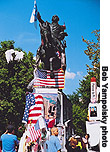| |
The Talk of New York
The flag
By Bob Yampolsky
|
|
星条旗の意味

|
|
ユニオンスクエアにあるジョージ・ワシントンの乗馬像
|
|
New York's never been a flag-waving town. It has too many immigrants, is home to too many international institutions, and is too politically liberal for the simplistic patriotism that (we suspect) underlies the reverence that other parts of the country hold for the flag. In Manhattan, you're far more likely to see a foreign flag than you are to see the Stars and Stripes. But all that has changed. Now you see the American flag everywhere.
There are flags in storefronts, flags hanging from apartment windows, flags on city buses, cabs, trucks, cars. Yesterday I counted the number of flags I could see as I walked one block on Broadway: 36. There was a flag on a baby stroller and a flag tied to a dog's collar. Several people had flag pins on their lapels. I did not count the red, white and blue ribbons that many people have pinned to their clothes. But I did count the woman who was dressed in a summery outfit that made her look like a large walking flag.
You will see many flags in front of firehouses, amid the bouquets of sunflowers and roses and showy late-summer annuals that pile up in honor of the firemen who died at the World Trade Center; 344 died, according to the latest count. The firehouse near my office, which lost seven men, is overflowing with flowers and flags and handwritten tributes that surround photographs of the men. "We could not be prouder of you, son," says one tribute. People stop, look, ponder and move on.
You will see flags, too, amid the pictures of lost loved ones that have been posted on walls across the city. "MISSING," the signs say, or, "Have you seen ..." or "Please help me find my daughter/son/husband/wife/father/mother," and then there is a photo, inevitably of a happy, optimistic face, a name, a physical description, a phone number to call.
These signs sprang up in the days after the attack, in the hope that someone missing was still alive, lying injured in some hospital, or wandering around dazed after the attack. There is little hope now, and these signs have become memorials, a testimony to happy lives cut short. Hundreds and hundreds of these signs are posted in the Times Square subway station, and here, in New York's biggest and busiest station, people stop, stand quietly and look.
There is a huge flag stretched across the front of the Stock Exchange Building. There are tiny flags on the sides of the bases at Yankee and Shea stadiums.
And there are many flags, too, at Union Square Park, which has become a focal point for calls for peace. A statue there of George Washington on horseback has been covered with peace signs and paper doves, and also with American flags. During the last great peace movement in the U.S., during the Vietnam War, the flag was seen by many as a symbol of militarism and oppression, and in liberal bastions like Manhattan, it was more likely to be burned than waved. But the flags we see today do not carry such political connotations. The flags and the peace signs on George Washington do not clash.
To be sure, some of the first people to display flags were our Sikh taxi drivers, who with their turbans and beards look a little bit too much like Osama bin Laden. The corner store where I buy coffee and the paper is run by a group of Arab men who, on the surface, look little different from the hijackers of those four planes. They have grown noticeably friendlier and more polite and at the same time more nervous since Sept. 11, and you wonder whether they might have hung the flag outside their door more out of self-preservation than patriotism.
I certainly understand their concern, but as of yet, there have been no reports of violence or threats against Muslims or Arab-Americans in New York, and the mayor immediately made clear that he would not tolerate such acts. At the Afghan restaurant near my house (which now has an American flag next to the large map of Afghanistan in its window), business has picked up considerably since Sept. 11, as people have made a point of showing that they bear no ill will toward the Muslims and Middle Easterners among us.
So at the moment, I do not see militarism and intolerance in the display of all these flags. The prevalent mood in New York is of shock and sadness, and there is little thought of revenge and few cries for war. We are a diverse country, and at times the only thing that all Americans share is the fact that we are Americans. So it is only natural that in a time of national crisis we resort to the flag as an expression of solidarity.
How long any of this will continue is anybody's guess. In times of war, patriotism and solidarity can easily turn into jingoism, and loyalty to the flag can easily turn into suspicion of anyone who chooses not to wave one. Personally, I have faith in the good sense of my fellow New Yorkers and (to a slightly lesser extent) my fellow Americans. But if there is another attack, who knows how people will react? One thing that the events of Sept. 11 have taught us is that nothing at all is certain, and that it only takes a day for the world to change completely.
Shukan ST: Oct. 12, 2001
(C) All rights reserved
|



